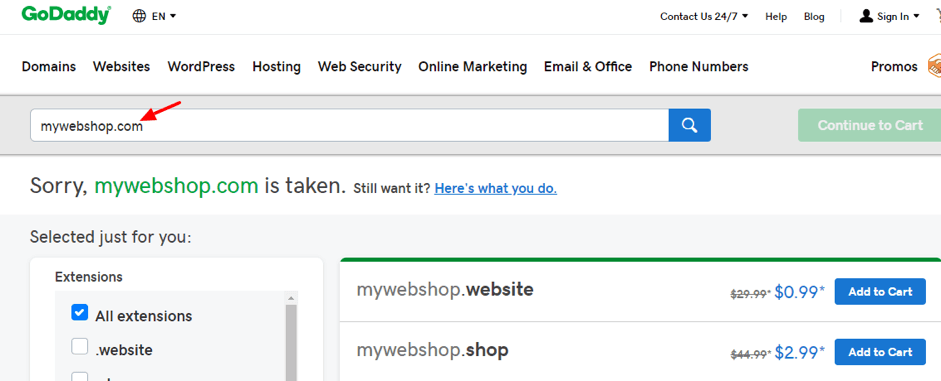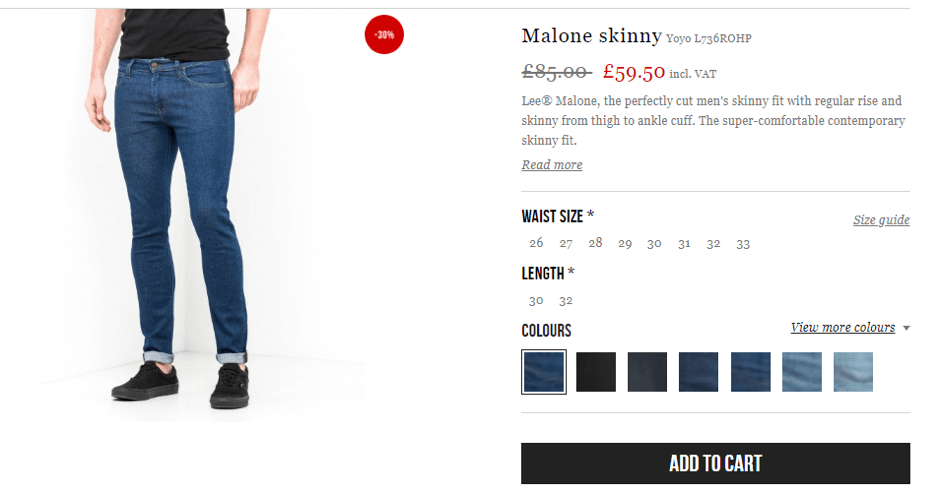The eCommerce industry isn’t new; however, it is still growing at an unprecedented rate. eCommerce companies generate trillions of dollars in sales every year because, according to the statistics, digital retail sales are going to hit $7.4 trillion in 2025. So, if your business is not on the digital forefront, then your business is losing the opportunity to reach the audience beyond your horizons.
Evolving times require an evolved strategy to survive the competition. Having both a physical store and a digital storefront is necessary to convert your leads into customers. Around 86% of global consumers shop online, and that’s why owners of brick-and-mortar retail stores are investing increasingly in creating an online store. Not only that, but new digital-first brands are popping up with eCommerce stores.
There are currently 12 and 24 million online retailers across the globe. With a majority of online stores being powered by Shopify or WooCommerce, setting up an online storefront isn’t that hard. All you need is a clear strategy and a good eCommerce website development agency. Icecube Digital is your agency, and we have a simple but effective strategy that will help to build an online store easily.

See How Our Experts Can Drive More Traffic to Your Website!
SEO: Boost your rankings and drive more organic traffic today!
Website Design/Development: Create a stunning website that converts visitors into customers.
Paid Media: Reach the right audience at the right time with expertly managed paid media.
A Step-by-Step Guide to Build an Online Store Successfully
- Do Some Market Research
- Selecting the Right Domain Name for Your Web Shop
- Prepare an Effective Business Plan
- Choose the best eCommerce platform
- Designing eCommerce website
- Developing all The Front End and Back End Functionality
- Decide Product Categories
- Prepare Product Pictures & Videos
- Write product descriptions
- Set up payment gateways
- Configure Shipping Options
- Web hosting and SSL certificate
- Search engine optimization
- End-to-end testing
- Social media & content marketing strategy
- Regular maintenance
Let’s Discuss Each Point in Detail
1) Do Some Market Research
Market research is more than just studying your competitors. It is more about understanding the needs of your target audience and how the current market fails to cater for that. Let’s understand how you can conduct market research to find your area to shine:
-
Conduct a SWOT Analysis
SWOT stands for Strengths, Weaknesses, Opportunities, and Threats Analysis. Here’s how you can get started:
- Strengths mean what makes your brand stand out from the competition. It can be anything like a new feature in your product, a skilled and experienced team, a robust supply chain, and even effective marketing strategies.
- Weaknesses highlight the areas that need improvement. Like, a 24/7 customer support team, inadequate funding, limited digital marketing experience, and other internal vulnerabilities that need to be addressed.
- Opportunities mean the emerging trends in your industry that you can leverage to boost your sales.
- Threats are external risks, like price wars, saturated markets, and aggressive competition.
-
Find Industry Gaps
Industry gaps analysis helps find the uncovered customer demands that you can bridge through your services. Here’s how you can do that:
- Use social media and analyze your target audience’s concerns, complaints, and recommendation requests.
- Collect feedback from the audience through different channels and analyze those.
- Look at the best sellers on eBay and Amazon. Read the reviews, check out their tutorials, and see what the shoppers are missing.
-
Create Your Ideal Customer Personas
Creating user personas for your ideal customer type helps you recognize their needs and requirements, which helps you develop a better product/service. Creating user personas is simple, and here’s how you can do it:
- Gather the existing customer data and describe their customer needs and pain points.
- Map out the ideal experience with your product/service.
- Give your personas a life by adding minute details like name, age, marital status, occupation, and location.
- Write a bio, organize the different elements, and refine them.
-
Choose Your Business Model
Now, the next step is to choose a business model as per your target audience. As per the business model, you can build your feature-rich website that closely aligns with your customers. Here are the different business models:
- B2B (Business-to-Business) eCommerce: When you want to sell to retailers, wholesalers, and business buyers, for example, Alibaba.
- B2C (Business-to-Consumer): When you want to market your products directly to consumers, like Amazon.
- Selling on online marketplaces like Amazon and eBay: When you want access to a wider customer base of the online marketplaces without having to setup your separate eCommerce website.
- Dropshipping: When you don’t want to hold any inventory, the shipping is done by a third party; all you need is to take orders. For example, Oberlo.
- DTC (Direct-to-Consumer): The DTC model eliminates the intermediaries like Glossier.
2) Selecting the Right Domain Name for Your Web Shop
Once you have done all the required research and identified all the products that you want to sell on your web shop, the next step is to purchase the domain name to be used for your eCommerce website.
A domain name is an address where Internet users can access your business website. Selecting the right domain name around your business industry is very important as it adds credibility to your business in the long run.
You can buy a domain name of your choice from various sellers available in the market like Godaddy, Bigrock, Namecheap, and such as others.
3) Prepare an Effective Business Plan
Starting a web shop is definitely a great idea with lots of opportunities but with technological advancements, the market is changing faster than ever and a clearcut business plan would help you to stand out.
Market and competitors research is being performed on a priority basis will help you to prepare a solid business plan with essential considerations of potential customers. Understand their needs when they buy online and what you should offer on your website to deliver them the best shopping experience.
Your webshop will have an impact on almost every area of your business including Sales-Marketing, Customer Service, Accounting, and Information Technology. When you start to put a plan together, understand how your eCommerce web shop can reach each corner of your organization and help your business to grow in long run.
4) Choose The Best eCommerce Platform
The next step is to select the best eCommerce platform suitable for your business needs. Selecting the right digital platform to build your web shop can have a huge impact on the success of your online business.
Since many different platforms are available in the market, it can be challenging to select the platform that effectively fulfills all your needs and fits your budget. So, browse through some of them and check which ones offer the best features that meet your needs.
For example, if you want to sell products with different variations, then look for a platform that lets you do that (Shopify does). On the other hand, if you have no experience in website development and design, it’s best to choose one with lots of themes/templates (BigCommerce has more than 100).
If you want an all-in-one solution that combines online stores and other sales channels like eBay and Amazon, then look for one with multi-channel selling capability (Volusion has this feature).
Here are Some Points that You Need to Consider while Selecting an eCommerce Store Solution:
– Pricing
– Flexibility to implement custom designs and features
– Possibility and ease of third-party system integration
– Mobile-friendliness
– In-built marketing features are available
– Ease of order & inventory management
– Possibility to scale as your business grow
– SEO friendliness
– Security
If you are starting with a small amount of inventory and you don’t need much custom functionality, any WooCommerce development company will suggest checking WooCommerce as it has all the functionality a standard webshop needs.
And If you are a well-established business with big SKU numbers and need lots of custom features to provide your end-users with a wonderful shopping experience, Magento and Shift4Shop are the best eCommerce platforms available in the market.
There are some other good self-hosted eCommerce platforms available that you should explore too.
5) Designing an eCommerce Website
It’s not that tough to design a simple CMS website but designing a fully functional eCommerce website has lots of challenges as it is built not only to showcase your products and services, It is built to motivate your users to shop online. Consider hiring an experienced eCommerce website design company to design your webshop.
A great design is attractive and easy to read with intuitive navigation. Your customers should be able to easily find what they are looking to buy or they will switch to your competitors. The usability of your webshop can be increased by displaying product and service information clearly and concisely.
Here Are Some Tips for Designing a Great eCommerce Website:
- Keep it uncomplicated and straightforward for users
- Make your business’s branding a priority
- Easy to navigate categories
- Make checkout a zap simple
- Make it responsive
- Adding social proof
6) Developing all The Front End and Back End Functionality
Once the design of all the webshop pages is done, the next step is quality development or coding on the eCommerce platform you have selected. There are certain features that every eCommerce website should have to stay competitive.
The success of your ecommerce website is determined by not only the products & services you offer and how well the website is designed, but also by the features your website offers both for the customers and the website owner.
Effective product pages and intuitive checkout are the most important part. Never make it hard for buyers to select required product options and checkout with the minimum steps possible.
Quick loading time for every page is very crucial and one of the most important factors behind loading speed is how effectively your website coding is done. Hire experienced eCommerce developers who can build your website with all the coding standards in place.
7) Decide Product Categories
The better the product categorization is on your eCommerce website, the easier it would be for your customers to locate specific products that they need.
Irrespective of the product you are selling, it is crucial to know how your users will search for your products and develop a well-organized product categories structure.
An accurate category/subcategory structure will not only help you to improve the user experience on your website, but it will also help to rank your site high on search engines for certain keywords.
There are a number of different ways to categorize your products, consult a professional SEO services agency to further understand and implement category structure in the best possible manner.
8) Prepare Product Pictures & Videos
You should discuss with your Magento 2 certified developers about the required picture size on different sections of the new webshop and start working to arrange it when the development is in progress.
A good picture speaks a thousand words. When someone lands on your website, their attention first goes to the pictures that you have used and if they like what they see – they will browse more on your website. Good quality product pictures on your eCommerce website will help you to convert more visitors into buyers.
According to recent research, about 71% of consumers think that video explains products better. Product explainer videos on your website will make it easy for users to understand everything about your products and help them to make a buying decision. You won’t deny the fact that people these days like videos more than reading long texts.
9) Write Product Descriptions
eCommerce website owners usually underestimate the importance of quality content. Though you use good quality product pictures or product explainer videos, your customers will have lots of other questions about your products which you can address by writing detailed product descriptions.
Unique and user-friendly product descriptions will help to boost the search engine ranking of your product keywords.
Relying on a product description generator can make things a lot easier. It can help you create compelling product descriptions by highlighting the key features and benefits.
Here are some points to consider while writing a product description:
- First of all, explain who this product is for.
- List out the important product characteristics.
- Make sure that your description helps your buyers to make a decision.
- Suggest when someone needs this product.
Refer to know more detailed information on how to write effective product descriptions.
10) Setup Payment Gateways
Payment gateways are an integral part of the eCommerce webshop checkout process. If you don’t offer the right and easy payment gateway options to your customers, your eCommerce business will not be successful.
You should offer your customer all major payment gateway options such as PayPal/Braintree, stripe, direct bank transfer, Credit & Debit Cards, and more.
While selecting the payment gateway, you should check for PCI compliance and SSL certificate in order to avoid any security problems in the future.
11) Configure Shipping Options
Most online buyers care about the shipping options you provide and the delivery fees you charge. According to the UPS survey, 45% of shoppers abandoned a cart when the order value didn’t qualify for free shipping. In fact, unexpected shipping costs are the most significant reason shoppers abandoned their carts.
Therefore, you should integrate shipping methods that offer your customers faster and cheaper delivery options on your website. If you are unable to satisfy your customers in either area, then you will lose the sale.
You should clearly specify order delivery dates with the live order tracking feature. A positive delivery experience will increase the trust of customers and encourage them to shop again.
12) Web Hosting and SSL
Web hosting is basically a space on a server where your website lives. You need to buy a reliable hosting service to make your new webshop available to the public.
Your web hosting service will have a huge impact on the performance of your webshop so be careful while selecting a hosting company. Consult with your web design company to get their advice regarding required hosting package specifications suitable for your business needs.
You would also need to integrate SSL on your website to offer your buyers with a secure shopping experience. You can get an SSL certificate from your hosting provider.
13) Search Engine Optimization – SEO
SEO is the process of improving the organic search rank of your webshop using some set of tactics. If your potential customers cannot find your web shop on search engines, you will lose a big opportunity for sale.
eCommerce business owners generally ignore SEO just because they do not know how important it is for the long-term success of the business.
SEO should be integrated with your webshop design and development process. If you don’t know how to do it, here is our ultimate eCommerce SEO guide.
14) Testing
Your ecommerce website development team will do the testing of the site on different browsers and devices but you should also keep testing the things on your end to make sure that each section of the website is working very well before it is launched.
A website that has not been properly tested may look fine in one browser and device but break apart in another and if any functionality doesn’t work – users will simply go elsewhere.
Once the webshop is live, you should keep doing A/B testing to identify what works and what does not. Here are some tools that can be used to test an eCommerce website:
- UsabulityHub: This tool helps you to improve the UX of your eCommerce websites.
- FiveSecondTest: Using this tool, you can make sure that your message is communicated effectively. It gives an idea about what any person recalls about your website design.
- Optimizely: It allows you to test track, conversions, clicks, or anything that is important to your eCommerce business.
15) Content & Social Media Marketing Strategy
Only building a good web shop is not enough, you should plan to market it well for success. Content marketing and social media marketing are the two most important pillars of your ecommerce marketing strategy.
Content marketing is all about creating useful content for your target audience and distributing it through different channels.
Creating & sharing valuable content on regular basis will help to increase customers’ trust in your brand and represent your business as an authority in your niche. It will also help to boost conversions and search engine rankings.
Social media is another important channel to engage with your buyers and ultimately increase sales. Integrating social media into your ecommerce store marketing is very crucial.
16) Regular Maintenance
Your job will not end when the design and development of your webshop are finished. In order to run it smoothly, it is important to monitor and maintain it regularly for any possible issues.
Implementing and maintaining a website is not a simple task. It requires a lot of effort to ensure that it runs smoothly. As the site grows bigger, it needs more time and attention to keep it completely functional, secure, and up-to-date.
Moreover, it is important to monitor your website regularly for any possible issues. If you fail to do so, you may face many serious problems. You will lose your customers, and it will be difficult for you to get them back.
A poorly managed site can also negatively affect your position in search engines. This means that you need to employ good website maintenance strategies for the better performance of your website.
Our eCommerce website maintenance guide will help you to maintain your webshop well.
Summary Statistics:
After reading this blog, you must have understood how to make an online store and how to navigate the process. A well-structured and effective eCommerce website is beautiful, functional, and persuasive.
Remember, online businesses never close, and businesses with websites grow between 15-22%. So, regardless of what you are selling, handmade candles or chocolates, a website is not something nice-to-have, but a must-have.
Around 59% of people admitted they prefer to shop online because, first, it is easier, and secondly, it is super convenient. So, you have the demand, and all you need is a good eCommerce website optimized for search engines and designed for the users to supercharge your sales funnel with high-quality leads.
Setting up an eCommerce website is an ongoing effort, and it never stops. So, you can consult with an eCommerce website design and development company, like Icecube Digital, to help you set your foundation solid. Our experts will guide you through the entire journey, from ideation to maintenance.










